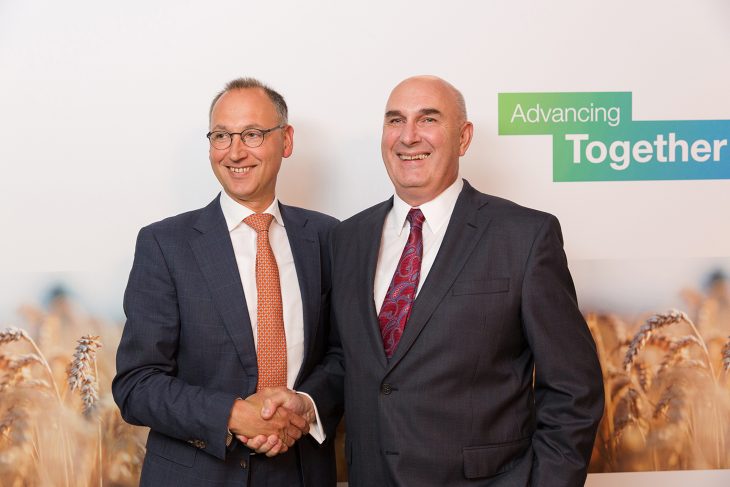Condon gave an update to members of the agricultural media at this week’s 2017 Future of Farming Dialog at Bayer’s world headquarters in Monheim, Germany. Here are some of the highlights.
1. Monsanto’s seeds and traits business is what initially attracted Bayer to Monsanto, says Condon. He says both companies are complementary with each other, with Monsanto being strong in seeds and traits and Bayer being strong in crop protection.
Corn and soybeans are a major emphasis of both Bayer Crop Science and Monsanto, but both also have significant wheat-breeding operations. Condon, though, says there is little overlap between the two wheat businesses because the firms have different approaches.
2. Product stewardship will be a focus of the new company. Off-target movement of dicamba used in dicamba-tolerant soybeans has been a major headache for Monsanto this summer. Condon couldn’t specifically comment on this.
“What I can say is, the whole topic of stewardship is incredibly important, that products are used in an extremely responsible manner,” he says. “That is important for the joined company going forward.
“We have dicamba in some of our selective herbicides in the U.S., and there have been no issues to date, because the right stewardship measures have been in place.”
3. Divestments will be made. Overall, Condon says little potential overlap between Bayer and Monsanto exists. Monsanto is big in seeds and traits and has generic crop-protection products, he says. Meanwhile, Bayer is big in crop protection with limited seeds and trait offerings.
Regulators and analysts following the merger have noted the one joined company would have two nonselective herbicide systems in row crops with dicamba-tolerant (Roundup Ready 2 Xtend) and glufosinate-tolerant technology (LibertyLink).
Selling the LibertyLink glufosinate-tolerant system has been batted around by stock analysts as a way to make the deal proceed. That’s not necessarily the case, though, says Condon.
“It is, by far, not a done deal, for the simple reason that regulators need to decide what they see as appropriate solution. That is one option, but none of that has been decided,” says Condon.
During the merger talks, there was a divestment calculation made tallying $1.6 billion.
“The $1.6 billion was a calculation we did basically looking at the overlap between the two companies, and what would be the maximum amount (of assets) to sell to get the deal done,” says Condon. The number may be less than that, though, he adds.
“We are in discussion with multiple interested parties who are highly interested in acquiring these assets (to be divested), either in total or parts of an overall package,” he says.
He says Bayer doesn’t have a preference about who the acquirers are. However, regulators do, because they want to ensure strong competition will still occur, he says.
“So, we could theoretically sell to a financial investor as a divestment solution. Most regulators would not consider that a sustainable solution, because the financial investor would (likely) sell it to someone else,” he says.
4. Bayer’s stock price has declined from 121.80 euros ($146) to 109.90 euros ($131.88) in the past three months, but it’s still higher than last year’s September 20 close at 92.10 euros ($110.52). “I am very happy compared with last year,” says Condon. “When the deal was announced (last year), it was a significantly lower number than where it is now. If you look at the investor analyst reports, the majority are saying buy or at least hold. There is only one sell recommendation.”
Condon says the most recent dip is related due to a rights issue to raise capital to fund the deal.
“Some investors are waiting for that to happen,” he says. Once investors know the details, they can plug it into their financial models and remove a degree of uncertainty that now exists, he says.
5. If the merger comes to fruition, the new company will likely continue looking for more acquisitions and partnerships, albeit smaller ones. Bayer recently launched a new company with a Boston firm named Ginkgo Bioworks, which designs custom microbes in multiple markets including agriculture. He sees Ginkgo Bioworks as the rare deal that could be highly disruptive due to the impact it could have on the ability of microbes to improve the way legumes (like soybeans and peas) fix nitrogen.
6. The anticipated close of the merger has been pushed back from the end of 2017 into late January 2018. This followed a discussion Bayer had with around 30 regulatory authorities around the world.
“Against the big picture, this does not make a (big) difference,” he says.
7. If the deal does close as anticipated in late January, customers will initially notice little change. “The reality is, to the outside world, not much will change,” says Condon. “The whole integration will take place over time. Customers won’t notice any disruption (on that date) whatsoever.”
8. For now, there’s no name change, but any such announcement will be made on the day of the close, says Condon.



